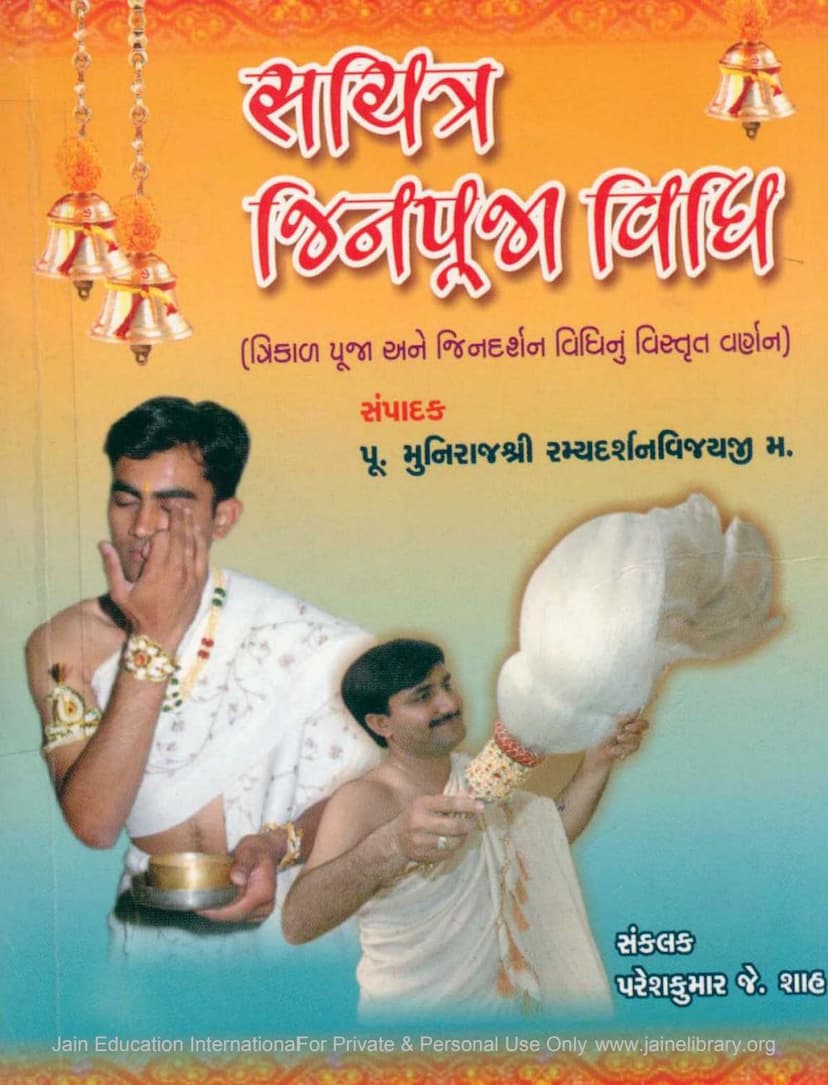Jina Pooja Vidhi Sachitra
Added to library: September 2, 2025

Summary
Here's a comprehensive summary of the Jain text "Jina Pooja Vidhi Sachitra":
Book Title: Jina Pooja Vidhi Sachitra (Illustrated Rituals for Worshiping the Jina) Author(s): Ramyadarshanvijay, Pareshkumar J Shah Publisher: Mokshpath Prakashan Ahmedabad
Overall Purpose and Scope: This book, "Jina Pooja Vidhi Sachitra," is a detailed guide to performing the rituals of Jain worship, specifically focusing on the "Trikala Pooja" (worship performed at three times of the day) and the general "Jina Darshan Vidhi" (ritual for viewing and honoring the Jina). It aims to provide clear, step-by-step instructions in a simple language, making the complex rituals accessible to all followers. The book emphasizes both the dravya pooja (worship with material offerings) and bhava pooja (worship with internal devotion and contemplation), stressing the importance of proper procedure and adherence to Jain principles of jayanā (careful conduct).
Key Contents and Themes:
-
Introduction and Blessings: The book begins with blessings and introductions from esteemed Jain Acharyas, highlighting the importance of devotion to the Jinas as a means to overcome worldly suffering and attain liberation. It is presented as a humble attempt to explain the vastness of devotion in a simple manner.
-
Essential Pooja Materials: Page 2 lists the common items required for Jain worship, including:
- Kalash (pot)
- Kesar-Sukhada (saffron and sandalwood)
- Chhabdi (basket) for flowers
- Dhupiyo (incense burner)
- Deepak (lamp)
- Akshata (unbroken rice)
- Phal (fruits)
- Naivedya (food offering)
- Darpan (mirror)
- Panhkha (fan)
- Chamara (fly whisk)
-
Detailed Rituals and Procedures: The majority of the book is dedicated to outlining the specific steps for various aspects of Jina worship and temple etiquette. This includes:
- Jina Darshan Vidhi (Viewing the Jina): This section covers how to approach the temple, what clothing and items are appropriate or inappropriate to bring, the importance of cleanliness, the process of entering the temple, offering salutations (Namo Jinanam), performing circumambulations (pradakshina), singing devotional songs (bhavavahi stuties), and the significance of various nisihis (prohibitions or renunciations).
- Trikala Pooja (Three-Time Worship):
- Pratahkal Ki Pooja (Morning Pooja): This ritual is described as purifying sins related to the night. It details the preparation of materials, the cleansing of oneself, the entry into the temple, and the performance of various poojas (Sukhada, Dhup, Deep, Akshata, Naivedya, Phal).
- Madhyahnakal Ki Pooja (Midday Pooja): This pooja is said to destroy sins of the present life and is described as encompassing the "Ashta Prakari Pooja" (eight types of worship).
- Sayankal Ki Pooja (Evening Pooja): This ritual is believed to destroy sins of seven lives. It outlines the simplified pooja process after sunset.
- Specific Pooja Steps: The book elaborates on the detailed procedures for:
- Ang Puja (Worship of individual body parts of the idol): This includes bathing (pakshal), applying paste (vilepan), washing, and drying.
- Ang Rachna (Angi - decoration/adornment of the idol): This covers the artistic adornment of the idol with various materials.
- Kesar Pooja (Saffron worship): Emphasizes using the ring finger and maintaining silence.
- Pushpa Pooja (Flower worship): Details the selection and offering of flowers.
- Dhup Pooja (Incense worship): Explains the proper way to perform dhup pooja.
- Deepak Pooja (Lamp worship): Outlines the procedures for lighting and offering lamps.
- Darpan Darshan and Pankha Vinjvana Vidhi (Mirror viewing and fanning): Describes the devotional act of viewing the Jina in a mirror and fanning.
- Chamara Pooja (Fly whisk worship): Explains the dance-like offering with fly whisks.
- Akshata Pooja (Rice worship): Details the creation of auspicious symbols with rice.
- Naivedya Pooja (Food offering worship): Describes the offering of sweets and fruits.
- Phal Pooja (Fruit offering worship): Outlines the offering of fruits.
- Chaitya Vandan Vidhi (Ritual of saluting the temple/idol): This section provides the script and methodology for chanting mantras and performing prostrations. It includes instructions on performing Kaushagga (a form of meditation) and reciting various sutras like Iriyavahiyam, Anuththara, and Logassa.
- Pachkkhana (Vows/Fasting): Instructions for taking daily vows and observing fasts are provided.
- Prostrations and Salutations: Various forms of bowing and salutations (e.g., Pranam Trika, Anjali) are explained.
- Index (Anukramanika): A detailed table of contents is provided, listing all the sections and their corresponding page numbers.
-
Ethical Conduct and Ahimsa (Non-violence): Throughout the book, there is a consistent emphasis on the Jain principles of jayanā (careful conduct), particularly concerning the protection of life forms (jeev-jantu). This is evident in instructions regarding the handling of materials, movement within the temple, and the preparation of offerings.
-
Specific Guidelines for Men and Women: While many rituals are gender-neutral, the book occasionally provides specific instructions for men and women regarding their attire and conduct.
-
Importance of Purity and Devotion: The text repeatedly stresses the need for inner purity, devotion, and the correct attitude (bhava) during worship, alongside the outward rituals.
-
Guidance on Temple Etiquette: The book offers practical advice on what to wear, what not to bring into the temple, and general decorum to maintain the sanctity of the place of worship.
-
Illustrations: The title "Sachitra" implies that the book is illustrated, visually aiding the understanding of the rituals.
In essence, "Jina Pooja Vidhi Sachitra" serves as a comprehensive manual for Jain devotees, aiming to guide them in performing their worship with utmost diligence, devotion, and adherence to the principles and practices prescribed by the Jain tradition. It bridges the gap between knowledge and practice, empowering individuals to connect with the divine through prescribed rituals and heartfelt devotion.